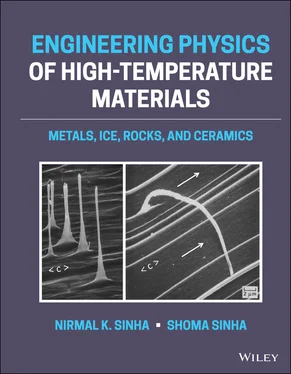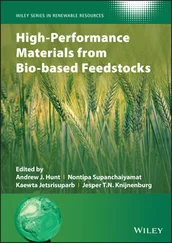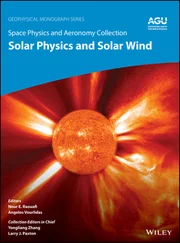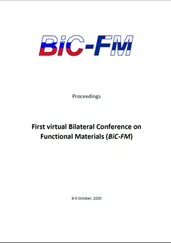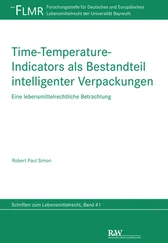Nirmal K. Sinha - Engineering Physics of High-Temperature Materials
Здесь есть возможность читать онлайн «Nirmal K. Sinha - Engineering Physics of High-Temperature Materials» — ознакомительный отрывок электронной книги совершенно бесплатно, а после прочтения отрывка купить полную версию. В некоторых случаях можно слушать аудио, скачать через торрент в формате fb2 и присутствует краткое содержание. Жанр: unrecognised, на английском языке. Описание произведения, (предисловие) а так же отзывы посетителей доступны на портале библиотеки ЛибКат.
- Название:Engineering Physics of High-Temperature Materials
- Автор:
- Жанр:
- Год:неизвестен
- ISBN:нет данных
- Рейтинг книги:3 / 5. Голосов: 1
-
Избранное:Добавить в избранное
- Отзывы:
-
Ваша оценка:
- 60
- 1
- 2
- 3
- 4
- 5
Engineering Physics of High-Temperature Materials: краткое содержание, описание и аннотация
Предлагаем к чтению аннотацию, описание, краткое содержание или предисловие (зависит от того, что написал сам автор книги «Engineering Physics of High-Temperature Materials»). Если вы не нашли необходимую информацию о книге — напишите в комментариях, мы постараемся отыскать её.
Discover a comprehensive exploration of high temperature materials written by leading materials scientists Engineering Physics of High-Temperature Materials: Metals, Ice, Rocks, and Ceramics
Engineering Physics of High-Temperature Materials (EPHTM)
Engineering Physics of High-Temperature Materials
Engineering Physics of High-Temperature Materials: Metals, Ice, Rocks, and Ceramics
Engineering Physics of High-Temperature Materials — читать онлайн ознакомительный отрывок
Ниже представлен текст книги, разбитый по страницам. Система сохранения места последней прочитанной страницы, позволяет с удобством читать онлайн бесплатно книгу «Engineering Physics of High-Temperature Materials», без необходимости каждый раз заново искать на чём Вы остановились. Поставьте закладку, и сможете в любой момент перейти на страницу, на которой закончили чтение.
Интервал:
Закладка:
1.8.1 Paradigm Shift in Experimental Approach
The history of cultures and nations, including various economic and political aspects of the inhabitants, provides opportunities to look back and make judgments that can, eventually, influence and improve our understanding of the global society. Looking back is always healthy as long as the approach is rational and forward looking. This approach has been the key to success for the development of science and technology and building bonds between diverse societies and linguistic groups of the world using a more‐or‐less common multidisciplinary scientific and technical language and jargon. A thorough and critical, but unbiased (hopefully), review of literature is therefore essential for embarking on any scientific work. It is said, “Hindsight 20‐20.” Why not apply this approach with a fresh outlook to high‐temperature materials science? But then, what would be that approach?
Materials exhibit elastic and inelastic deformation on application of a load. Inelastic deformation is commonly known as plastic. The paradigm of plasticity theories was developed on the basis of engineering experience with materials at low homologous temperatures. Plastic deformation is thought to occur when stress exceeds a specific range. The thoughts of practitioners in several engineering disciplines are molded by theories of plasticity proven to be very successful in explaining failures. Plastic deformation is traditionally assumed to be independent of time and hence independent of strain rate or stress rate. As a consequence, failure processes of geological materials have continued to be presented/discussed in terms of yield functions, yield surfaces, yield diagrams, envelops, etc. As the operational temperature rises, complex issues related to time–temperature effects complicate matters.
Inadvertently, plasticity theories have created confusion for many aspects of engineering materials science in general at elevated temperatures. Yield strength is, for example, very subjective and depends on the user of the information and materials. For example, “yield strength” in mechanical metallurgy and materials engineering, in general, is used to mean the stress corresponding to a specific strain, such as 0.2% offset strain on stress‐strain diagrams. Strength of engineering materials, especially at elevated temperatures, is known to be rate dependent, and inelastic deformation leading to permanent changes in a solid depends on time, among other parameters. Consequently, a small shift in paradigm occurred. Yield strengths had to be defined with respect to a specific range of loading rates. Nowadays, measurement of 0.2% yield is undertaken through uniaxial constant strain rate or more often constant crosshead or displacement rates with respect to “tensile tests” or “compressive tests” (mainly for ceramics, rocks, and ice) at some specific strain rate between 5 × 10 −5s −1and 1.2 × 10 −4s −1(ASTM 1998). These considerations led us to the use of the word “viscous” for any permanent deformation, irrespective of the micromechanisms (dislocation or diffusion) involved in inducing the changes in the shape of a body. By looking back at the history of the theoretical front and engineering practices, we will try (as mentioned earlier in several places) to avoid the use of the term “plastic strain” in this book. However, we recognize that the terms like plastic deformation and plastic strain continue to be used strongly for describing inelastic strain even for high temperatures, such as creep strain. We recognize that paradigm shifts take time. For this reason, we will often remind the reader about the equivalency of the two terms: viscous and plastic.
1.8.2 Breaking Tradition for Creep Testing
On the experimental front, constant‐load or constant‐stress creep tests are customarily performed at elevated temperatures. Room temperature creep tests are also performed on certain materials exhibiting low‐temperature ductility. The uniaxial tension test or compression creep test is the simplest and fundamentally most important test for the evaluation of material properties. The tradition is to load a specimen and monitor the evolution of strain. No specific efforts are made to determine the elastic modulus, such as Young's modulus (E), corresponding to the initial microstructure of the test specimen. At some stage, either the load is removed intentionally or by rupture. The post‐test analysis concentrates typically on stress–time–temperature dependence of strain and strain rate, and sometimes on microstructural examinations at room temperature. Almost invariably, the characteristics of the minimum creep rate (mcr), often considered as the steady‐state flow rate, are discussed. It is trendy to report only the mcr, time to rupture ( t f), and elongation (engineering strain) at failure, ε f. Efforts are also sometimes made, but not necessarily as a normal practice, in fitting the creep curves for the transient creep, especially, for example, in the case of rocks.
High‐temperature deformation processes are continuous, and each regime depends on earlier deformation and microstructural history. Materials remember their thermomechanical history! What happens if the load is applied (rise time) in fractions of second and if the creep (strain relaxation) test is terminated by unloading in fractions of second after a short creep or strain relaxation time of t SRand the strain ε (recovery) is monitored continuously for a long time? It should provide a historical record of strain that recovers immediately (elastic, ε e), strain that recovers with time (delayed elastic, ε d), the permanent or viscous strain, ε v, accumulated during t SR, and an average viscous strain rate  v= ε v/ t SRfor the period t = 0 +to t SR. How does ε dvary with time? How does
v= ε v/ t SRfor the period t = 0 +to t SR. How does ε dvary with time? How does  vvary with time, stress, temperature, and initial (constant) microstructure?
vvary with time, stress, temperature, and initial (constant) microstructure?
Why not stop the test, unload the specimens completely (unlike partial unloading used in “strain‐ or stress‐transient dip tests”) during the creep test, as well as during other tests, such as constant‐strain‐rate strength tests and constant‐strain SRTs, and monitor the strain–time response for extended periods and evolution of strain trinity? This is like looking backward (hindsight) at the growth history of elastic, delayed elastic, and viscous characteristics.
This book revolves around the concept of opening up the door for hindsight and using the opportunity it offers for developing both experimental and theoretical approaches. This is a recurring theme of various chapters.Experimental procedures were developed to examine not only total deformation, but also the three strain components: elastic, recoverable delayed elastic, and permanent viscous strain. Most importantly, theoretical developments can also be judged not only by how well they predict the total deformation under specific external conditions, but also how well they predict the strain components.
It is well known that viscous flow (dislocation creep creep) exhibits stress‐wise highly nonlinear response, with stress exponent, n v, varying from a value of 4 for pure metals to significantly higher values for complex alloys. It is shown in Chapters 5and 6that delayed elastic response could exhibit nearly linear to highly nonlinear response, with stress exponent, s , varying from 1 to 4 for complex nickel‐base superalloys, so far examined experimentally. However, the ratio, n v/ s , may not vary significantly for different materials examined so far. The n v/ s ( n v= 11.8 and s = 4.0) ratio of ≈3 for the nickel‐base superalloy IN‐738LC is similar to that of 4.3 for another nickel‐base superalloy – Waspaloy is also very close to that of 3.3 for titanium‐base alloy Ti‐6246 ( n v= 4 and s = 1.2) and is exactly like that of polycrystalline ice with n v/ s = 3 ( n v= 3 and s = 1); however, ice is not a metal!
Читать дальшеИнтервал:
Закладка:
Похожие книги на «Engineering Physics of High-Temperature Materials»
Представляем Вашему вниманию похожие книги на «Engineering Physics of High-Temperature Materials» списком для выбора. Мы отобрали схожую по названию и смыслу литературу в надежде предоставить читателям больше вариантов отыскать новые, интересные, ещё непрочитанные произведения.
Обсуждение, отзывы о книге «Engineering Physics of High-Temperature Materials» и просто собственные мнения читателей. Оставьте ваши комментарии, напишите, что Вы думаете о произведении, его смысле или главных героях. Укажите что конкретно понравилось, а что нет, и почему Вы так считаете.
